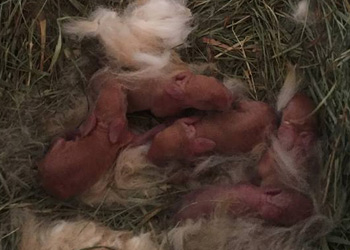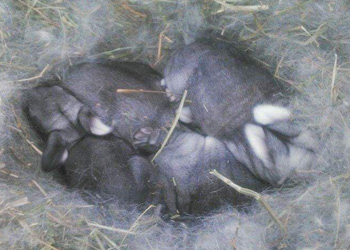There is an old saying that rings particularly true with Flemish Giants. ‘They’re like chips, you can’t have just one.” Most people who are interested in becoming a rabbit owner are instantly awe-struck by the size & gentle nature of Flemish. It’s “love at first sight”, in most cases. This is where the obsession begins! Then, before too long, the need for more starts to grow & another Giant is brought home, if not done at the same time as getting the first one. Next, some people become thoroughly fascinated with this great breed. After spending a bit of time with one, or two, it is quickly realized how smart, & how affectionate they are. By then also, the bunny-owner has generally gone some home-work. They have learned about feeding, housing, basic care, & with that comes the gained education about the breed in general. From there, if that persons time & space allows, they may decide to increase their investment. This, as well as an intention to show them, leads up to breeding.
First steps in becoming a flemish giant breeder

Lovely young flemish giants!
As it is the case with any species, it goes without saying that breeding is best successful when certain conditions are met. It is also noteworthy to add that the person who coined the phrase ‘breed like rabbits’, clearly never attempted to breed rabbits; doing so is not always as easy as it sounds. In regards specifically to Flemish Giants, there are possibly even more items on the list of certain criteria that first must be met in order to produce full-blood, good quality, healthy babies. In order do this, you want to breed the best possible buck to the best possible doe. For that, & other reasons, you should only breed them when you can answer the questions of “Why are you breeding them?” & “What are your plans for the babies?”
You should understand that only certain varieties (colors) should be bred together, & that just because one person has a Flemish buck & another person owns a doe of a different (or the same) breed, that does not mean the two should be bred together. In fact, that should not be done at all. It does nothing to improve the breed; instead it just leads to problems later down the road. It is important to remember “quality over quantity is always better.” In addition to this, before breeding, you need to have a set goal for what you want to produce, & a solid market for selling them – or be fully prepared to keep & raise every baby that is produced. On average, even with a great buck, an equally impressive doe, & a complete goal of improvement of the breed, you should be aware that on average you will likely only end up with one such baby out of a litter of 7. With all this said, however, lets’ get started!
P.S. Make sure to list your rabbitry at our website.
FREE! Fill in the form here and get your rabbitry listed among the other Flemish giant breeders across the United States, United Kingdom & Canada.
Questions & Answers
In order to get you started we have listed several of the most common questions that might arise and included answers.
1. How old do Flemish need to be before breeding them?
Bucks & does alike need to be of senior age, which is at or above 8 months old.
2. How much should my Flemish weigh when they are bred?
The minimum breeding weight is the same as the weight standards for showing them; being no less than 13 pounds for bucks / 14 pounds for does (per ARBA standard. Respectfully, there is a 2 pound decrease of each per BRC standards).
3. How do I know if my doe is ready to be breed?
Rabbits do not have a heat-cycle like dogs or cats do. Therefore, breeding can occur at any time. However, the doe will be more receptive to being bred if her vent area is a dark pink, red, or purplish color. (However, here are “tricks of the trade”-see that section of this site for more details- that can be used for pushing a doe into being more receptive.)
4. How do I know if my buck is ready to be bred?
Bucks become sexually mature when their testes become visible. Otherwise – “they’re guys”… they’re always ready! (ha ha)

1 day old

5 days old
5.Can I breed a Black-to-White or a Sandy-to-Blue Flemish Giants?
No – this should not be done. There are strict color-standards regarding what varieties should / should not be bred together. To keep it simple, only breed same colors together. However, for more experienced breeders asking this – please see further detail noted in the section specifically designated for Varieties.
6. How do I breed my buck & doe together?
(A) For safety reasons, it is suggested to “table breed” them. This means that a large, very sturdy/solid non-slippery surface is needed. Place both on that surface, & let nature take her course. *Note – do not leave them unattended! Injury to one or both can happen in the blink of an eye; especially if one is an aggressive breeder. (B)If the above is not an option, take the doe over to & put her into the bucks’ hutch. *Again, do not leave them unattended while they are together.
7. How do I know if the mating was successful?
a. When breeding, the buck will always mount the doe, who will stretch out a little, while lifting her rear-end, giving the buck access to breed her. Once he mounts her, the mating will take place very quickly, often within 2-5 seconds. As soon as he is done, he may make a ‘squealing noise’ (though not always) & then he will “fall off” of her. In doing so, he may physically fall over, landing on his side, next to her. (This is common, don’t worry – he didn’t have a heart attack or anything; he will get up quickly.)
8. What happens after the buck falls off?
At this time, pick the doe up & roll her over onto her back (using the correct way of doing so, for your safety & hers). Check her vent area. There will visibly be thick white fluid there if the breeding was successful. If so, tilt or raise her rear-end up a bit; this doesn’t need to be a significant amount, but enough for gravity to do its part. (This is not a *must do* step. It simply increases the odds that she will then become impregnated.)
9. Once all of the above is completed, should I let them breed again?
Yes. For optimal results, it is best suggested to allow them to mate at least 3 times – following the above steps after each breeding – before separating them.
10. How long will it take the doe to have babies?
Providing that the breeding was a successful impregnation, the doe will kindle 28 – 31 days from the date she was bred.
11. Do I need to give the doe a nest box to have the babies in?
(A) While it is common practice with most breeds of rabbits, Flemish Giants getting a nest box is optional. IF you have a box large enough to accommodate the doe comfortably, it will not hurt to give it to her. When / if you do, fill it with straw when you give it to her. This should be done approximately 2-3 days before she is due to kindle. By presenting days before delivery, it will not stress her out to have a new object in her house. Once it is given to her, do not bother her any more than what is necessary. This can be a stressful time, & she will be quite busy with arranging the straw how she wants it to be as well as resting up for her upcoming babies to enter the world.
(B) HOWEVER… if you do not have a large, roomy box for her – no worries. Instead, put a significant pile of straw in one corner of her house. She will begin arranging the straw, usually immediately. During this time of nesting, do not bother her. Let her arrange as she sees fit & in the manner and in the time she chooses. *Note: some Flemish will do better with this option, as it allows her more space to access the babies.
12. How will I know when my doe is in labor?
More commonly than not, she will pull lots of fur off of her chest, belly, & sides and will line the straw-nest with the fur. This is not painful to her, & in fact is a sure way to know that in a short time, delivery will begin. Most of the time, delivery will occur when she is alone, & everything is calm & quite. From the time she pulls fur, the babies may be born any time from immediately up to 24 hours. Once the kits are born, she will pull more fur to cover them with. This is done because newborn kits are born hairless, & they chill very fast & easily. If they chill to the point of getting cold, they will not survive.
13. How many babies do Flemish Giants usually have?
The average sized litter for a Flemish is 6-10 kits, however, it’s not entirely unheard of to have as few as 2, or for a big whopping litter of up to 19 or even 21. Experienced breeders will tell you though, when those super-sized litters happen, the doe may physically separate the kits into different piles. The reason for this is not that she plans to abandon half of them. What she is doing is increasing their chance of survival; a doe only has so many teats to be nursed from – by having smaller piles of babies, this increases the odds of each & every baby getting fed.
In need for more answers? Make sure to read our FAQ section.
